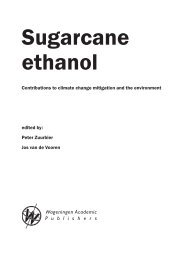Production and use of fuel ethanol in Brazil - BAFF
Production and use of fuel ethanol in Brazil - BAFF
Production and use of fuel ethanol in Brazil - BAFF
You also want an ePaper? Increase the reach of your titles
YUMPU automatically turns print PDFs into web optimized ePapers that Google loves.
A2. History <strong>of</strong> sugar-cane grow<strong>in</strong>g <strong>and</strong><br />
<strong>ethanol</strong> production <strong>in</strong> <strong>Brazil</strong><br />
A2.1.<br />
What were the historical conditions <strong>in</strong> which the<br />
sugar-cane agribus<strong>in</strong>ess activities began <strong>in</strong> <strong>Brazil</strong>?<br />
In colonial times, the <strong>Brazil</strong>ian economy —at the whim <strong>of</strong> the Portuguese<br />
metropolis— developed by cycles, accord<strong>in</strong>g to the <strong>in</strong>terests <strong>and</strong> vicissitudes <strong>of</strong> the<br />
<strong>in</strong>ternational market. First, we experienced the brazil wood cycle, followed by the<br />
cane sugar cycle <strong>and</strong>, f<strong>in</strong>ally, the gold cycle. In colonial <strong>Brazil</strong>, each <strong>of</strong> these products<br />
went through an expansion period <strong>and</strong> then a decl<strong>in</strong>e stage.<br />
Dur<strong>in</strong>g the First Reign (1822-1831), the Regency (1831-1840) <strong>and</strong> the Second Reign<br />
years (1840-1889), the sugar made <strong>in</strong> <strong>Brazil</strong> competed with that made <strong>in</strong> the Antilles<br />
— from the sugar-cane brought by the Dutch follow<strong>in</strong>g their expulsion from <strong>Brazil</strong>,<br />
— as well as the beet sugar that had been produced on large scale <strong>in</strong> Europe s<strong>in</strong>ce<br />
the 17 th century. The heavy taxes imposed by the various governments on sugar<br />
imports were then a strong h<strong>in</strong>drance to the trade.<br />
The Oligarchic Republic (1889-1930) marked the peak <strong>and</strong> decl<strong>in</strong>e <strong>of</strong> the agricultural<br />
export-based economy. In addition to c<strong>of</strong>fee, which after a great expansion <strong>in</strong> the<br />
first decades went through a severe crisis <strong>in</strong> the 1920’s, other products like rubber,<br />
cocoa nuts <strong>and</strong> sugar also experienced expansion <strong>and</strong> decl<strong>in</strong>e cycles.<br />
A2.2.<br />
How did the sugar-cane agribus<strong>in</strong>ess develop<br />
over the follow<strong>in</strong>g years?<br />
The restructur<strong>in</strong>g <strong>of</strong> <strong>Brazil</strong>’s sugar-cane agribus<strong>in</strong>ess production — which<br />
undoubtedly facilitated the modern <strong>in</strong>dustry that we have today — was <strong>in</strong>itiated <strong>in</strong><br />
the early 1930’s <strong>and</strong> was only possible thanks to the State’s <strong>in</strong>tense action over a<br />
little longer than six decades <strong>of</strong> strong governmental <strong>in</strong>tervention.<br />
Start<strong>in</strong>g <strong>in</strong> 1933, when the Sugar <strong>and</strong> Alcohol Institute (IAA) was created, the<br />
Government took over a number <strong>of</strong> activities that back then determ<strong>in</strong>ed the ways<br />
<strong>of</strong> the sugar-cane agribus<strong>in</strong>ess. The state’s <strong>in</strong>tervention dom<strong>in</strong>ated practically all<br />
<strong>of</strong> the <strong>in</strong>dustry’s structure, <strong>and</strong> was responsible for the production <strong>and</strong> market<strong>in</strong>g<br />
cycle, <strong>in</strong>clud<strong>in</strong>g pric<strong>in</strong>g, quotas, exportation <strong>and</strong> importation.<br />
A. Fuel <strong>ethanol</strong>: Activities <strong>in</strong> <strong>Brazil</strong> <strong>and</strong> the world context<br />
19












